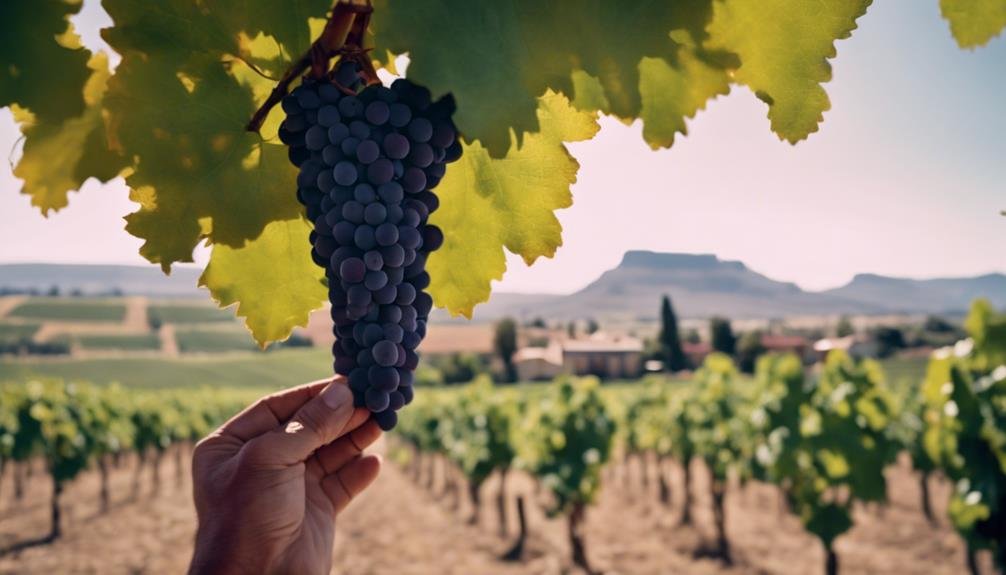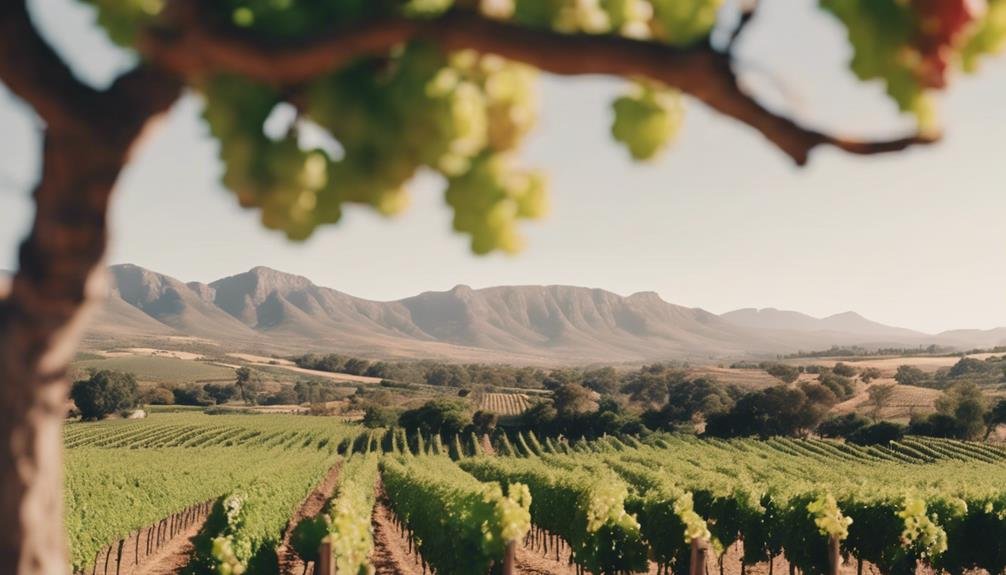Explore South Africa's Pinotage, a unique grape intertwined with history. Originating from a 1925 Cinsaut and Pinot Noir cross, this varietal faced quality challenges but now thrives across diverse terroirs. Expect bold flavors of purple and black fruits, with hints of plum sauce and tobacco, benefiting from aging to soften tannins. Winemakers focus on meticulous crafting, fermentation methods, and aging processes to create well-balanced wines. Taste the influences of South African regions like Stellenbosch and Swartland. Embark on a journey of discovery into the world of Pinotage, where a rich tapestry of flavors and techniques awaits exploration.
Pinotage Grape: Origins and Characteristics
The legacy of the Pinotage grape is intricately woven with the pioneering spirit of South African viticulture, boasting a rich tapestry of origins and distinctive characteristics that set it apart in the world of wine.
Initially crossed in 1925 by scientist Abraham Perold, Pinotage is a blend of Cinsaut and Pinot Noir. Despite its promising beginnings, Pinotage faced misconceptions due to low-quality commercial production, tarnishing its reputation. However, the grape thrives in South Africa's diverse terroir, offering unique aging potential.
Pinotage's bold flavors of plum sauce, tobacco, and licorice are complemented by its dense color and high tannins. With time and proper aging, Pinotage wines can evolve into complex and sophisticated expressions, showcasing the true essence of South African winemaking.
Pinotage Wine: Flavor Profile and Characteristics
Characterized by its bold and distinctive flavors, Pinotage wine showcases a unique profile that sets it apart in the world of wine.
- Flavor Profile: Pinotage commonly features purple and black fruit flavors, with hints of plum sauce, tobacco, and licorice.
- Aging Potential: Pinotage wines often benefit from aging, allowing the bold tannins to soften and the flavors to integrate.
- Food Pairings: Due to its robust nature, Pinotage pairs well with grilled meats, spicy dishes, and aged cheeses.
- Terroir Influence: Pinotage's flavor can be influenced by the terroir, with notable regions like Stellenbosch and Swartland in South Africa producing exceptional examples.
Pinotage Winemaking: Techniques and Variations

In the world of winemaking, the crafting of Pinotage involves a meticulous process that showcases the grape's bold and unique characteristics. Fermentation methods play an essential role in shaping Pinotage wines, with some winemakers opting for traditional methods while others experiment with modern techniques to enhance flavors and aromas.
The aging process is also significant, as it allows the wine to develop complexity and depth over time. Oak influence is a common practice in Pinotage winemaking, with different types of oak barrels imparting distinct flavors and textures to the final product.
Blending techniques are another aspect where winemakers can showcase their skills, combining different grape varieties to create well-balanced and harmonious Pinotage wines that truly capture the essence of this South African gem.
Pinotage Tasting Notes: Good Vs. Bad
When exploring Pinotage wines, distinguishing between exceptional and subpar tasting notes is important for wine enthusiasts seeking quality and flavor authenticity. Here are some key points to keep in mind when evaluating Pinotage wines:
- Pinotage faults: Identifying faults in Pinotage wines is essential to avoid unpleasant experiences. Common faults include pungent and sharp smells resembling nail polish remover, indicative of high levels of Volatile Acidity (VA).
- Common misconceptions: It's important to dispel misconceptions about Pinotage, such as the belief that all Pinotage wines are of inferior quality. While some may have faults like burnt tar flavors from over-extraction, well-made Pinotage can showcase a range of complex flavors like rooibos, bacon, and sweet pipe tobacco.
- Tasting notes: Good Pinotage should exhibit purple and black fruit flavors with bold tannins and a sweet finish. Winemakers may acidify the wine to enhance balance and integration.
- Winemaking techniques: Understanding the winemaking processes for Pinotage can provide insights into the final tasting experience, helping distinguish between well-crafted and poorly executed wines.
Madeline Puckette: Wine Folly Co-founder

Continuing our exploration of Pinotage wines and the nuances of wine tasting, a prominent figure in the wine education landscape is Madeline Puckette, the co-founder of Wine Folly.
With a focus on wine education and communication, Madeline Puckette, a James Beard Award-winning author and Wine Communicator of the Year, plays a significant role in the wine industry.
Through Wine Folly, she actively engages in flavor exploration, providing valuable insights into different wine varieties. Her work aims to educate people about wine, making it accessible and enjoyable for all enthusiasts.
Frequently Asked Questions
How Does Pinotage Compare to Other Popular Grape Varieties?
Pinotage stands out with its bold flavors of plum, tobacco, and licorice. Compared to other popular grape varieties, Pinotage often features darker fruit notes, robust tannins, and unique flavors like rooibos and bacon. Winemakers may adjust acidity to enhance balance.
Are There Any Unique Health Benefits Associated With Pinotage Wine?
Pinotage wine offers unique health benefits with its high levels of antioxidants like resveratrol, linked to heart health. Its bold flavor profiles of dark fruits and tobacco notes, coupled with aging potential, make it a promising choice for both palate and well-being.
What Food Pairings Complement Pinotage Wine Best?
When pairing Pinotage wine, consider rich cheeses like aged gouda or blue cheese. For desserts, opt for dark chocolate or berry-based treats. The bold flavors of Pinotage complement the savory richness of cheeses and the sweetness of decadent desserts perfectly.
How Does the Aging Process Affect the Taste of Pinotage Wine?
The aging process greatly impacts Pinotage wine, enhancing its flavor profile through oak influence. Tannin structure evolves, offering aging potential. Over time, the wine softens, showcasing complex notes of dark fruit, spice, and earthiness, resulting in a harmonious and well-rounded palate.
Can Pinotage Be Used in Blending With Other Grape Varieties?
Pinotage, known for its bold flavors and high tannins, offers versatility in blending with other grape varieties. Its rich characteristics, like dark fruit notes and robust tannins, can enhance blends, creating unique and complex wines.
Conclusion
To sum up, Pinotage stands as a unique and bold gem in the world of wine, with its origins in South Africa and rich flavors of plum sauce, tobacco, and licorice.
Despite initial challenges, Pinotage has evolved to become a wine of character and complexity, deserving recognition for its distinct qualities.
One may argue that Pinotage's boldness may not suit everyone's palate, but its diversity in flavor profiles offers something for every wine enthusiast to explore and enjoy.
